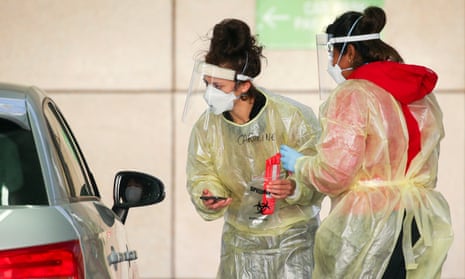A Covid-19 modeller has suggested New Zealand’s North and South islands could become separate bubbles as the country grapples with a coronavirus outbreak, although South islanders with hopes of being fully released from lockdown should not hold their breath just yet.
New Zealand is battling to contain an outbreak of the Delta variant that swiftly led to a nationwide, level four lockdown – the highest setting – which has been extended until at least the end of the week. There are now 210 cases in the community.
Auckland – the largest city, where the majority of cases have been detected – will remain in lockdown until the end of the month.
There have been no cases in the South Island, but the 20,000-strong list of close contacts linked to the current outbreak extends across both islands. Around 120 people, who were potentially exposed to the virus at locations in Auckland, are isolating in the South Island.
Auckland could expect to stay in lockdown for a number of weeks , but a North Island and South Island split could make sense, Covid-19 modeller at the University of Auckland, Shaun Hendy, told TVNZ.
“I think at this stage, a North Island and South Island split is probably what we’d be looking at,” Hendy said.
In order for the alert levels to drop in the South Island, any wastewater tests would need to come back clear, Hendy said.
Wellington would still need to be cautious, given the 12 positive cases there, Hendy said.
Also speaking to TVNZ, the director general of health, Dr Ashley Bloomfield, said the options for different alert levels between the two islands were being considered, but he did not anticipate anywhere outside of Auckland dropping below level three restrictions just yet.
Level three is the second-toughest lockdown measure: public venues remain closed, people are required to stay in their bubbles and gatherings are limited to no more than 10 people. Travel between regions is restricted.
Bloomfield said the number of cases was expected to rise significantly again on Thursday but health officials were hoping to see the numbers peak in the next day or so.
There was also potential for an “internal boundary” in the North Island – perhaps around Auckland – while the rest of the country drops to level three restrictions, Bloomfield said.
“We’ve always gone down through the levels, so down from four to three, so we wouldn’t anticipate having anything I wouldn’t have thought lower than a three outside of Auckland.
“There’s a lot of work happening across government to look at those options.”
On Wednesday, Queenstown Lakes District mayor Jim Boult told Stuff he could not see the point of the South Island moving into alert level three and it should move directly to level two.
“If we’ve got no cases in the South Island come the end of the week, and we’re pretty much past the incubation period, then it’s time to get a bit of normality back.”
Health officials will update the nation on new case numbers on Thursday afternoon. The prime minister, Jacinda Ardern, will make an announcement about the nationwide lockdown settings on Friday.
